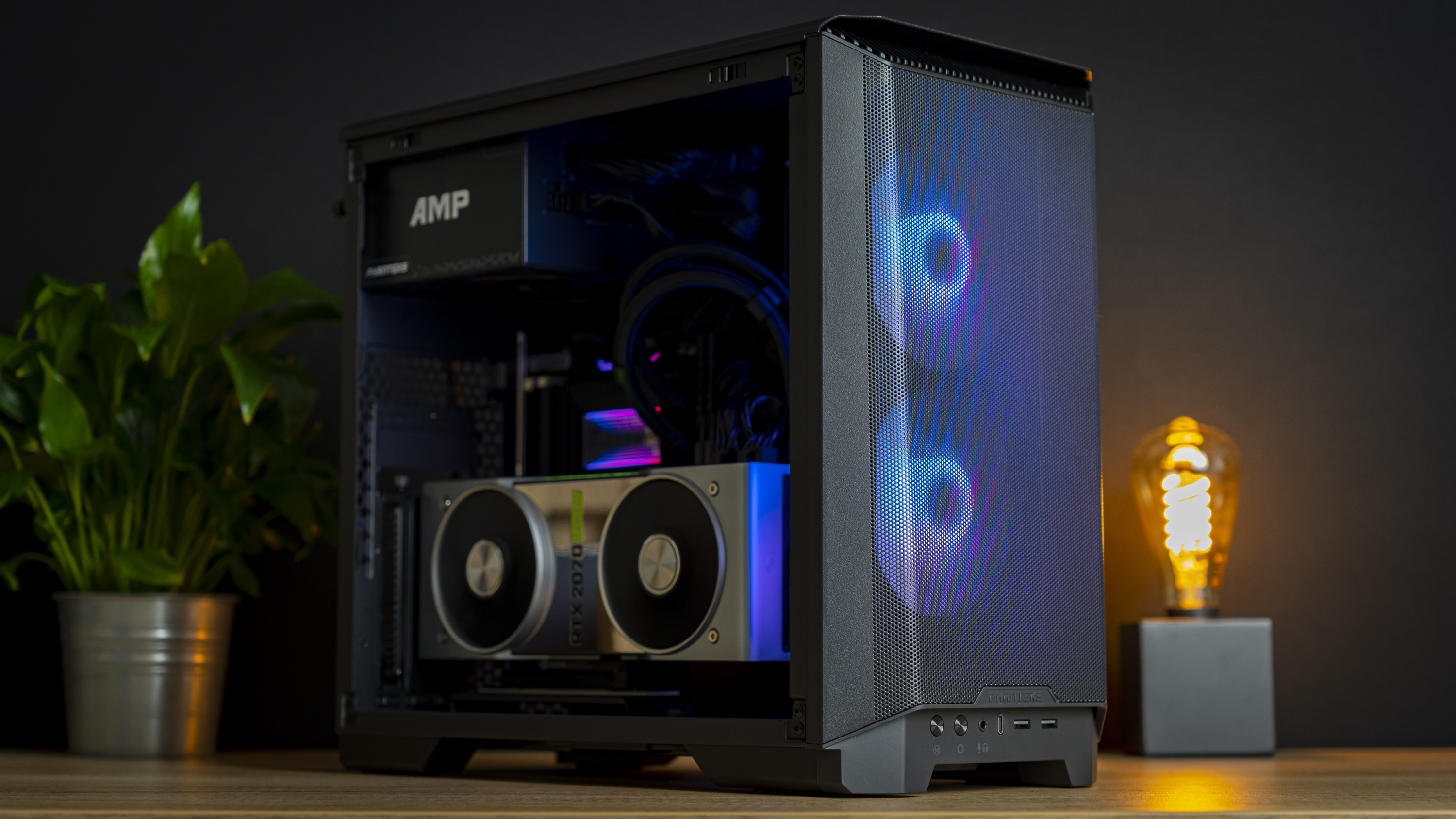Why you can trust Tom's Hardware
For thermal and acoustic testing, other than fan speeds, we’re running the hardware we have entirely at stock settings to mimic the results you can achieve as closely as possible.

Fan Characteristics
The two included fans are, despite the budget nature of the case and RGB implementation, actually quite good spinners. They have PWM support and are surprisingly efficient with regards to noise levels vs. cooling performance. They can spin at a minimum speed of just 400 RPM and will ramp up all the way to about 1400 RPM at full duty. Without an extra layer of filtration behind the front mesh, this means the chassis gets plenty of fresh air.
Acoustic Results
Acoustically, the Phanteks P200A offers very respectable results, achieving an optimized idle noise level of just 33.9 dBA, jumping up to 39.5 dBA with the case fans at full blast. Max out the 240mm AIO with its fans spinning at 2200 RPM, and the RTX 2070 Super FE at 75% and noise levels quickly become obtrusively loud, but that’s to be expected -- you shouldn’t run your system with fan speeds this high anyway. As with any mesh system, try to find parts that run quiet and preferably find a GPU with a Zero-RPM mode so that it’s quiet most of the time when you aren’t gaming.
Thermal Results
For the thermal tests, all case and CPU fan speeds are set to 100 percent, and the GPU fan is set to run at 75 percent fan speed.
Thermally, the Phanteks Eclipse P200A is equally impressive. Funnily enough, the CPU and GPU temperatures were matched, with a reading of just 59 degrees Celcius when normalized to a 20-degree room. Remove the intake panels (front and side), and we witness a temperature decrease of only 2 degrees, which goes to show just how well optimized Phanteks’ mesh is -- it barely impedes airflow.
These figures are very impressive, and clearly there is plenty of thermal headroom to get those noise levels down a fair bit.
Conclusion
Phanteks’ P200A is essentially a tiny version of their larger Eclipse P-series cases, and all things considered it’s a brilliant little chassis. Okay, it’s a little big by ITX terms, and the top-mounted PSU gives off major 2005 vibes, but it’s a very affordable chassis that offers excellent thermal performance paired with a good amount of quality RGB.
Get Tom's Hardware's best news and in-depth reviews, straight to your inbox.
It won’t blow you away with materials quality, nor is the P200A’s layout very exciting, but it’s well put together, easy to work in and has no major flaws that stop me from giving it a recommendation. If you’re on a budget and just looking for a simple case to house a small gaming system, and all you care about is good performance, a great price, and some attractive RGB, the Phanteks P200A is certainly one to shortlist.
Niels Broekhuijsen is a Contributing Writer for Tom's Hardware US. He reviews cases, water cooling and pc builds.
-
gwlaw99 You are about an inch away from an matx case which can use better cheaper motherboards. I don’t see the point of mitx this sizeReply -
jkhoward Replygwlaw99 said:You are about an inch away from an matx case which can use better cheaper motherboards. I don’t see the point of mitx this size
Same, was eyeing the pictures and was like.. “Why not get a smaller mATX case and get more inputs? This has to be the same size as those.” -
State O' Maine I've been seriously eyeing this case. I'm currently in a Thermaltake Level 20 VT, and while it is a decent case, it is limited in regards to radiator support. I have a 280mm AIO which removes the possibility of adding any other additional fans to the top. Add on the fact that my EVGA 2080S Hybrid didn't fit till I moved the rad fan to the outside of the case...Reply
I'm in line for an EVGA 3080 Hybrid which is a 280mm rad. I'll be needing a new case and this P200a will fit 2x240 or a 240/280 combo. Add in that it takes a regular PSU and I'm intrigued. -
vinay2070 This pretty much looks like a mini version of my P600S. Too sad, if it was a slot taller then an mATX could be fitted in the same space like mentioned in the comments above.Reply -
JoBalz I noticed the reviewer's comment stating "Top PSU kind of weird.' I imagine there are others here, like me, who remember when a top mounted PSU was about the only placement you could find for the PSU in any type of tower case.Reply



